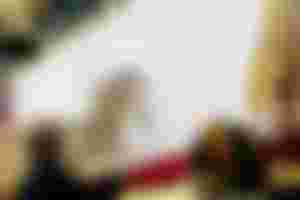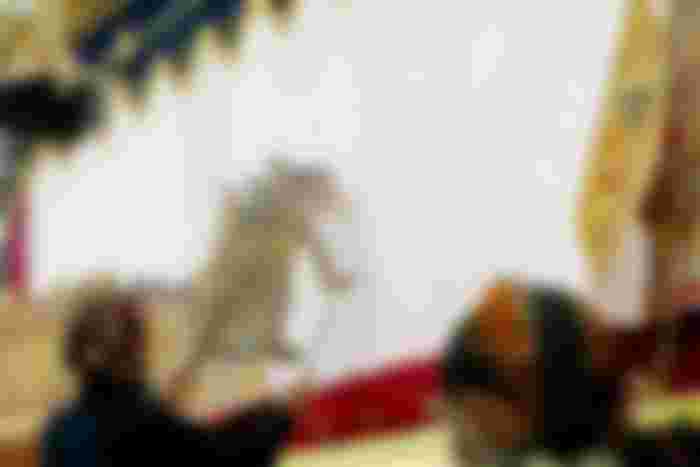.Wayang kulit originally developed in the palace environment. So folk art and spread to distant places.

.Wayang kulit art is born, lives, grows, develops, especially in Javanese society. More than just a show, wayang kulit was once a medium for contemplation towards the spiritual spirits of the gods. The term "wayang" itself comes from the word "ma Hyang", which means towards the spirituality of the Almighty. But there are also those who say “wayang” comes from a performance technique that relies on shadows (shadow / puppets) on the screen.
Wayang kulit, made from buffalo skin, is believed to be the embryo of the various types of puppets that exist today. He is played by a puppeteer; accompanied by gamelan music played by a group of nayaga (gamelan players) and a song sung by the singer. Every part in a wayang performance has a strong philosophical symbol and meaning. Especially in terms of content, puppet stories always teach noble character, love and respect for each other, while sometimes inserting social criticism and funny roles through goro-goro scenes. Wayang kulit has a long history. The oldest record of wayang kulit or wayang purwa is in the Kuti inscription dating from 840 AD from Joho, Sidoarjo, East Java. This inscription mentions the word haringgit or dalang. "Haringgit is a subtle form of the word ringgit. This word is still in Javanese, which means wayang, "noted Timbul Haryono, professor of archeology at Gadjah Mada University, in" Old Javanese Society and Its Environment during the Borobudur Period "published in 100 Years after the Restoration of Borobudur Temple. At that time, the puppeteer led and played puppet shows in the palace environment. Archaeologist Dyah W. Dewi in "Wayang Art in the Ancient Javanese Period and Its Distribution in Asia" said that wayang performances have a special meaning. "In connection with the holding of a ceremony to commemorate an incident," noted Dyah, in the V Archaeological Meeting.
Some puppet experts, such as R.M. Mangkudimedja, suspects that the original form of wayang was not what it is today. In the past, puppets were only visible in the front. The basic ingredients for making wayang are different from now. In the past, puppets were made from palm leaves, not the skins of livestock like now. But selingkar other archaeologists have denied the allegations of R.M. Mangkudimedja. For example Soedarso Sp. He believed that the puppets were made of leather. He based his views on the content of Kakawin Arjunawiwaha, an MPU Kanwa member dating to 1036 AD. Regarding the play in the early period shadow puppet show, only the Wukajani inscription from the reign of the King of Mataram named Dyah Balitung (907 AD) calls it quite clear. The Wukajani inscription mentions mawayang bwat hyang or wayang performances with the Bima Kumara play. This story is a fragment of the epic Mahabharata which tells of Kicaka's madness to Drupadi. Information about wayang kulit is also contained in reliefs in 10th century East Java temples such as Surawana Temple, Jago Temple, Tigawangi Temple, and Panataran Temple. The presence of shadow puppets in temple reliefs in three different places shows that this art has spread to various regions.
The development of shadow puppets entered a new chapter during the Islamic Sultanate. Wayang kulit is no longer exclusively the property of the palace environment. Islamic preachers in Java brought wayang kulit to grassroots communities. They also changed the forms of puppets so that they were in line with Islamic teachings and the purpose of da'wah. Some of the preachers of Islam were also reliable puppeteers. The most famous is Sunan Kalijaga The plays in the shadow puppet show during the Islamic era still take stories from the Mahabharata. But Islamic preachers include several new terms and figures in these plays. Among other things, four funny characters known as panakawan: Semar, Petruk, Bagong, and Gareng. The arrival of Europeans to the archipelago also gave wayang kulit a new color. Catholic missionaries from Sarikat Jesuit during the colonial period followed in the footsteps of Islamic preachers in using wayang kulit as a medium for spreading religion.
Although shadow puppets in a number of regions are open to new touches, wayang kulit in Yogyakarta and Surakarta still retain their standard model. This means that the puppeteers there make a number of provisions regarding the performance of shadow puppets. Starting from the form of puppets, plays, characters, to other technical equipment. Their standard refers to the performance of wayang kulit (shadow puppets) from the Old Mataram era. Since independence, Indonesia has had a number of high schools majoring in puppetry. From this institution, new possibilities for the development of rolling leather puppets were introduced. There were several times the performance of shadow puppets. Such as story plays, characters, and technical matters using digital screens and the latest technology. Although shadow puppets now appear in various faces, these performances are still captivating and enduring. Each type of show has its fans. People from far countries are also willing to come to Indonesia to study the history and forms of shadow puppet shows to then be rolled out in new forms in their respective countries. Wayang kulit was born, grew, lived in Indonesia, then spread all over the world. It is not wrong if the United Nations Educational, Scientific and Cultural Affairs (Unesco) has designated wayang kulit as a world cultural heritage from Indonesia. *

Oh I've never heard of this before. It looks like a great form of art. What does kulit mean though?